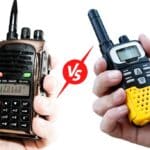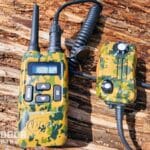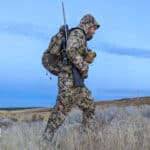Radios are excellent for facilitating long-distance communication.
Two-way walkie talkies are especially indispensable for hunters. I wouldn’t hunt with a partner without a radio for each of us.
However, walkie talkies don’t have as clear a sound as modern smartphones. When you press that transmit button, if you don’t speak properly, all the other guy will hear is garbled mud.
Because radio transmissions can be hard to understand, it’s a good idea to speak using walkie-talkie lingo.
This type of lingo has short yet multisyllabic words and phrases which transmit well over the air, and because they’re standardized, anyone who uses the radio will understand what you’re saying.
Why Use Walkie-Talkie Lingo?
At first, using walkie-talkie lingo sounds like a silly idea.
Why learn a few new words when you can talk normally over the radio?
People whose lives depend on clear radio communication talk the lingo. That’s because it’s short and easy to understand.
You see, radios don’t have perfect audio quality. Transmitting a person’s voice over audio waves is difficult to do, especially with a handheld device.
Cell phones use towers to get the power necessary for clear communication. Handheld radios don’t.
So, militaries, civilian pilots, and many other people around the world use what’s called Voice Procedure. This is a simple system of radio communication which decreases ambiguity. You’ll be easier to understand with fewer words.
Talking as you would to someone in the same room when speaking over the radio can come through garbled, short words such as “yes” and “no” are easily lost, and both you and your listener will get frustrated by not being able to understand each other.
Proper voice procedures, or using walkie-talkie lingo, can help prevent these problems and facilitate clear communication.
But first, let’s go over how to speak clearly into the radio in the first place.
How to Speak Clearly into a Radio
As mentioned before, it’s harder to understand people’s voices over the radio. Lingo can help with that, but even when using the proper lingo, you need to speak in a certain way.
Using a radio so everyone can understand you goes through three steps: cuing up the mic, speak slowly and enunciate every word, then end the transmission.
Let’s look at each step in detail.
- Cue Up the Mic
If you hit your radio’s transmit button right as you start talking, you won’t notice anything wrong, but your listeners will.
Radios take a moment to start transmitting properly. The process takes under a second, but it does take a noticeable amount of time. If you talk immediately, your first word or two will get cut off.
So, to be understandable over the radio, you need to pause after cueing up the mic. Waiting a beat or counting to one-Mississippi are two methods I’ve seen to delay speaking until the radio is ready.
I also know a guy who starts every phrase with “and” with the expectation it gets cut off. That works too, but he’s so into the habit that he starts sentences with “and” at home as well.
- Speak Slowly and Enunciate Every Word
This is the hardest part of radio communication for many people.
Words tend to blend together into garbage on the radio when you speak quickly. The slower you speak, the more easily you are understood.
Enunciation is also very important. Make sure to speak each word clearly and purposefully. It also helps to pause before and after important words.
For example, if you are on the western edge of the property, you might tell someone face-to-face, “I’m at the western edge of the property.”
But over the radio, you would want to say, “I am at the. Western. Edge. Of the property.”
This will reduce ambiguity and get your message across.
Notice how I didn’t say “loudly.” Radio microphones can pick your voice at normal speaking volume. Speaking too loudly or too close to the mic will just make you more difficult to understand!
- End the Transmission
Just like starting the transmission, resist the temptation to end the transmission immediately after speaking. It’s easy to accidentally cut off your last words, so wait a moment after talking to take your finger off the button.
Walkie-Talkie Lingo
The following words and phrases are standardized, so anybody who speaks over the radio will understand what you are saying.
When you know these phrases, you will be at home whether talking with airplane pilots, police dispatchers, or even a movie crew!
- “Affirmative”—Yes.
- “Come In”—Please acknowledge. (Used in conjunction with the name of the person you’re trying to contact.)
- “Copy”—I understood your message.
- “Disregard”—Please ignore my previous transmission.
- “Eyes On (Object)”—I can see whatever it is we’re talking about.
- “Go Ahead”—I’m listening; please transmit your message.
- “Go for (Your Name)”—I’m acknowledging a call made for me, please transmit your message.
- “Loud and Clear”—Your radio is working properly. (This is the answer to the next phrase.)
- “Mic Check” or “Radio Check”—Is my radio working? (Used with new radios or when you think the battery might be dead.)
- “Negative”—No.
- “Say Again” or “Go Again”—Please retransmit your message. (Note that “repeat” is not used over the radio. Saying “repeat” over the radio means, “Artillery units, fire again at the same target!”)
- “Roger”—Message received and understood. (Note that this doesn’t necessarily mean you’ll follow through…)
- “Stand By”—I acknowledge you calling for me, but I’m busy at the moment, so I’ll call for you when I’m ready.
- “On It”—I am in the process of doing what you want me to do.
- “Out”—I am finished transmitting over the radio for now.
- “Over”—I am done with my part of the transmission and am clearing the air so you can reply.
- “Wilco”—I will do what you want me to do. (Note that some people say “roger, wilco,” but “wilco” implies you understood the message, so you don’t need to say “roger” as well.)
- “(Your Name) Calling (Their Name)”—I want to talk with you. Then wait a moment and let them transmit, “go ahead” or, “go for so-and-so.” If they don’t reply after a handful of seconds you can say, “(Their Name), come in.”
Ten-Codes
Ten-codes were invented by the Illinois State Police in 1937 to further increase brevity and decrease ambiguity over the radio.
Many ten-codes are specific to police work and some vary from department to department. The following are generally understood wherever you may go, though.
To use a ten-code, all you do is say “ten” then the other number.
- 10-1—Officially this means “transmission unreadable,” but some people take it to mean “I need to take a short restroom break.”
- 10-2—Officially this means “transmission signal good,” but some people take it to mean “I need to take a long restroom break.” You know, number 1 and 2.
- 10-4—Acknowledged, understood.
- 10-5—Relay this transmission to someone else.
- 10-6—I’m busy, stand by.
- 10-9—Say again?
- 10-20—What’s your location? People will often say, “What’s your 20?”
Numbers and Letters
Sometimes, you need to spell something out over the radio, especially when trying to say someone’s name or another hard-to-understand word.
In these cases, spelling out the word is a good idea. But you don’t want to use the normal pronunciation of the letters because many of them blend together.
For example, it’s very hard to differentiate “d” and “t” over the radio.
So, use the NATO Phonetic Alphabet. It’s used worldwide.
- A—Alfa
- B—Bravo
- C—Charlie
- D—Delta
- E—Echo
- F—Foxtrot
- G—Golf
- H—Hotel
- I—India
- J—Juliet
- K—Kilo
- L—Lima
- M—Mike
- N—November
- O—Oscar
- P—Papa
- Q—Quebec
- R—Romeo
- S—Sierra
- T—Tango
- U—Uniform
- V—Victor
- W—Whiskey
- X—X-ray
- Y—Yankee
- Z—Zulu
Numbers, however, you pronounce normally (except for 9, in which case you say “niner”).
Conclusion
Walkie-talkie lingo, also known as voice procedures, is a bunch of phrases and ten-codes which allow for clear communication over the radio.
Many of us know phrases such as “roger” and “10-4” from movies and TV. The rest require some memorization.
This may seem like a lot of information to take in at once. But once you’re in the field and need to talk with your hunting partner after getting lost, you’ll be glad you know how to communicate without frustration.













